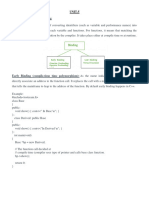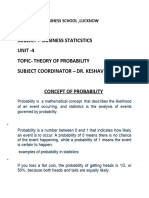C Virtual Functions
Uploaded by
AlbertC Virtual Functions
Uploaded by
AlbertC++ Virtual Functions
In this tutorial, we will learn about C++ virtual function and its use with the help
of examples.
A virtual function is a member function in the base class that we expect to
redefine in derived classes.
Basically, a virtual function is used in the base class in order to ensure that the
function is overridden. This especially applies to cases where a pointer of base
class points to an object of a derived class.
For example, consider the code below:
class Base {
public:
void print() {
// code
}
};
class Derived : public Base {
public:
void print() {
// code
}
};
Later, if we create a pointer of Base type to point to an object of Derived class
and call the print() function, it calls the print() function of the Base class.
In other words, the member function of Base is not overridden.
int main() {
Derived derived1;
Base* base1 = &derived1;
// calls function of Base class
base1->print();
return 0;
}
In order to avoid this, we declare the print() function of the Base class as
virtual by using the virtual keyword.
class Base {
public:
virtual void print() {
// code
}
};
Virtual functions are an integral part of polymorphism in C++.
Example 1: C++ virtual Function
#include <iostream>
using namespace std;
class Base {
public:
virtual void print() {
cout << "Base Function" << endl;
}
};
class Derived : public Base {
public:
void print() {
cout << "Derived Function" << endl;
}
};
int main() {
Derived derived1;
// pointer of Base type that points to derived1
Base* base1 = &derived1;
// calls member function of Derived class
base1->print();
return 0;
}
Run Code
Output
Derived Function
Here, we have declared the print() function of Base as virtual .
So, this function is overridden even when we use a pointer of Base type that
points to the Derived object derived1 .
Working of virtual functions in C++
C++ override Identifier
C++ 11 has given us a new identifier override that is very useful to avoid bugs
while using virtual functions.
This identifier specifies the member functions of the derived classes that override
the member function of the base class.
For example,
class Base {
public:
virtual void print() {
// code
}
};
class Derived : public Base {
public:
void print() override {
// code
}
};
If we use a function prototype in Derived class and define that function outside
of the class, then we use the following code:
class Derived : public Base {
public:
// function prototype
void print() override;
};
// function definition
void Derived::print() {
// code
}
Use of C++ override
When using virtual functions, it is possible to make mistakes while declaring the
member functions of the derived classes.
Using the override identifier prompts the compiler to display error messages
when these mistakes are made.
Otherwise, the program will simply compile but the virtual function will not be
overridden.
Some of these possible mistakes are:
Functions with incorrect names: For example, if the virtual function in the
base class is named print() , but we accidentally name the overriding
function in the derived class as pint() .
Functions with different return types: If the virtual function is, say, of void
type but the function in the derived class is of int type.
Functions with different parameters: If the parameters of the virtual function
and the functions in the derived classes don't match.
No virtual function is declared in the base class.
Use of C++ Virtual Functions
Suppose we have a base class Animal and derived classes Dog and Cat .
Suppose each class has a data member named type . Suppose these variables
are initialized through their respective constructors.
class Animal {
private:
string type;
... .. ...
public:
Animal(): type("Animal") {}
... .. ...
};
class Dog : public Animal {
private:
string type;
... .. ...
public:
Animal(): type("Dog") {}
... .. ...
};
class Cat : public Animal {
private:
string type;
... .. ...
public:
Animal(): type("Cat") {}
... .. ...
};
Now, let us suppose that our program requires us to create two public functions
for each class:
. getType() to return the value of type
. print() to print the value of type
We could create both these functions in each class separately and override
them, which will be long and tedious.
Or we could make getType() virtual in the Animal class, then create a single,
separate print() function that accepts a pointer of Animal type as its
argument. We can then use this single function to override the virtual function.
class Animal {
... .. ...
public:
... .. ...
virtual string getType {...}
};
... .. ...
... .. ...
void print(Animal* ani) {
cout << "Animal: " << ani->getType() << endl;
}
This will make the code shorter, cleaner, and less repetitive.
Example 2: C++ virtual Function Demonstration
// C++ program to demonstrate the use of virtual function
#include <iostream>
#include <string>
using namespace std;
class Animal {
private:
string type;
public:
// constructor to initialize type
Animal() : type("Animal") {}
// declare virtual function
virtual string getType() {
return type;
}
};
class Dog : public Animal {
private:
string type;
public:
// constructor to initialize type
Dog() : type("Dog") {}
string getType() override {
return type;
}
};
class Cat : public Animal {
private:
string type;
public:
// constructor to initialize type
Cat() : type("Cat") {}
string getType() override {
return type;
}
};
void print(Animal* ani) {
cout << "Animal: " << ani->getType() << endl;
}
int main() {
Animal* animal1 = new Animal();
Animal* dog1 = new Dog();
Animal* cat1 = new Cat();
print(animal1);
print(dog1);
print(cat1);
return 0;
}
Run Code
Output
Animal: Animal
Animal: Dog
Animal: Cat
Here, we have used the virtual function getType() and an Animal pointer ani in
order to avoid repeating the print() function in every class.
void print(Animal* ani) {
cout << "Animal: " << ani->getType() << endl;
}
In main() , we have created 3 Animal pointers to dynamically create objects of
Animal , Dog and Cat classes.
// dynamically create objects using Animal pointers
Animal* animal1 = new Animal();
Animal* dog1 = new Dog();
Animal* cat1 = new Cat();
We then call the print() function using these pointers:
. When print(animal1) is called, the pointer points to an Animal object. So, the
virtual function in Animal class is executed inside of print() .
. When print(dog1) is called, the pointer points to a Dog object. So, the virtual
function is overridden and the function of Dog is executed inside of print() .
. When print(cat1) is called, the pointer points to a Cat object. So, the virtual
function is overridden and the function of Cat is executed inside of print() .
You might also like
- Object Oriented Programming With C++ (203105337) : Prof. Payal Desai, Assistant ProfessorNo ratings yetObject Oriented Programming With C++ (203105337) : Prof. Payal Desai, Assistant Professor21 pages
- C++ Virtual Functions: Definition and Description: Runtime PolymorphismNo ratings yetC++ Virtual Functions: Definition and Description: Runtime Polymorphism9 pages
- Virtual Functions: Junaed Sattar November 10, 2008No ratings yetVirtual Functions: Junaed Sattar November 10, 200822 pages
- Unit 6 Virtual Function, Polymorphism, and Other C++ FeaturesNo ratings yetUnit 6 Virtual Function, Polymorphism, and Other C++ Features8 pages
- Virtual Function and Pure Virtual FunctionNo ratings yetVirtual Function and Pure Virtual Function4 pages
- CSE1002 - M7 - 2 - Pure Virtual Function and Abstract Classes - 31!05!23No ratings yetCSE1002 - M7 - 2 - Pure Virtual Function and Abstract Classes - 31!05!2357 pages
- EEN-103 Programming in C++: Dynamic Binding and Virtual Functions PolymorphismNo ratings yetEEN-103 Programming in C++: Dynamic Binding and Virtual Functions Polymorphism46 pages
- Chapter 7 Polymorphism_231119_152610 (3)No ratings yetChapter 7 Polymorphism_231119_152610 (3)22 pages
- C++ Polymorphism: Real Life Example of PolymorphismNo ratings yetC++ Polymorphism: Real Life Example of Polymorphism6 pages
- NU-Lec 10_Virtual Functions and Polymorphism - INo ratings yetNU-Lec 10_Virtual Functions and Polymorphism - I30 pages
- C++ Public, Protected and Private InheritanceNo ratings yetC++ Public, Protected and Private Inheritance1 page
- C++ Programming Default Arguments (Parameters)No ratings yetC++ Programming Default Arguments (Parameters)1 page
- United States Court of Appeals, Third CircuitNo ratings yetUnited States Court of Appeals, Third Circuit14 pages
- History of The Development of Education in The Philippines (Pre-Spanish To The Present)No ratings yetHistory of The Development of Education in The Philippines (Pre-Spanish To The Present)3 pages
- How An 18th Century Philosopher Helped Solve My Midlife CrisisNo ratings yetHow An 18th Century Philosopher Helped Solve My Midlife Crisis15 pages
- The Influence of the Student Team Achievement Division TypeNo ratings yetThe Influence of the Student Team Achievement Division Type9 pages
- Methods of Quantification and Characterization of Coccidian OocysNo ratings yetMethods of Quantification and Characterization of Coccidian Oocys42 pages
- OWIS Secondary School Calendar 2024-25.xlsx - Google SheetsNo ratings yetOWIS Secondary School Calendar 2024-25.xlsx - Google Sheets1 page
- OOP - Lab Task-5 - Methods - UML To JAVA CodeNo ratings yetOOP - Lab Task-5 - Methods - UML To JAVA Code3 pages
- Journey To The Centre of The Earth: (By Jules Verne)No ratings yetJourney To The Centre of The Earth: (By Jules Verne)7 pages
- What Is Translation - Looking Back - OnlineNo ratings yetWhat Is Translation - Looking Back - Online3 pages
- Accounting:: Information For Decision MakingNo ratings yetAccounting:: Information For Decision Making21 pages
- Mba ' Notes Theory of Probabilities in Business Statistics PDFNo ratings yetMba ' Notes Theory of Probabilities in Business Statistics PDF18 pages


































































































